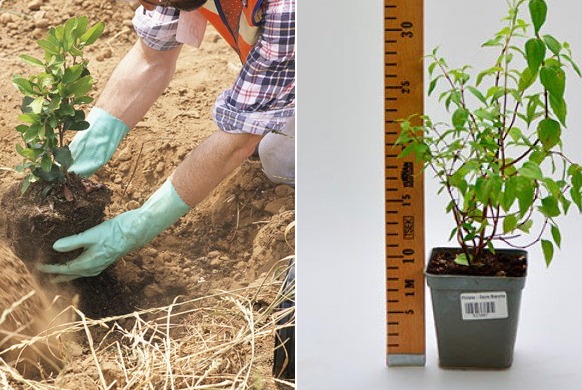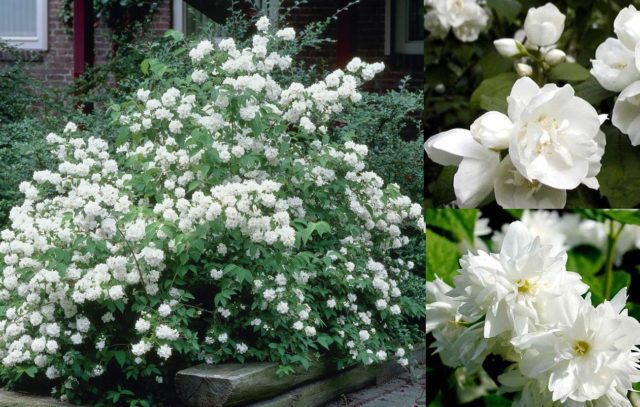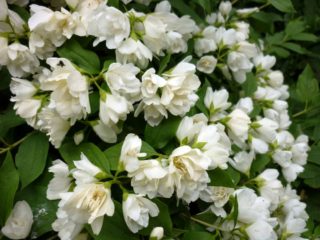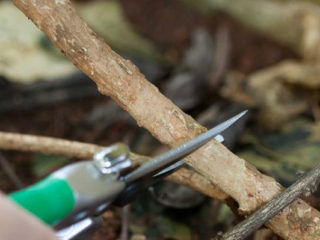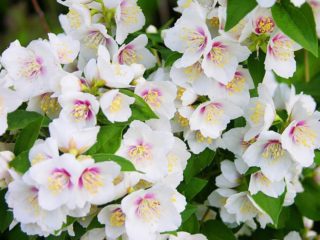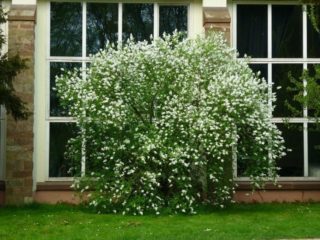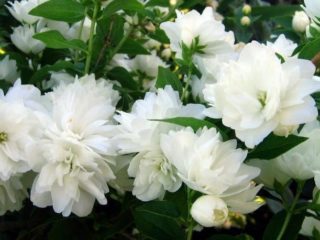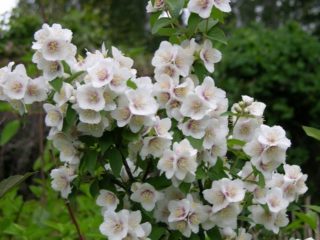Content
Chubushnik Dam Blanche is a hybrid bred by the French breeder Lemoine. This is a gorgeous, versatile plant during flowering that can cover unsightly corners of the garden or become the main highlight of a blooming composition. This jasmine variety is great for creating spectacular hedges.
Description of the chubushnik Dam Blanche
It should be noted right away that the mock-orange is not jasmine - these are different cultures. However, they have similarities in the abundance of lush bloom and the sweetish-viscous aroma of strawberry aroma. Therefore, the people call the chubushnik garden (false) jasmine.
Chubushnik Dam Blanche, as is clear from the description and the photo below, refers to dwarf shrubs. It is a neat, compact bush with a maximum height of 1.5 m and a crown diameter of 1 m. Dark green leaves are narrow, ovoid and small in size turn yellow by autumn, which enhances the decorative effect of the shrub.
How the jasmine Dame Blanche blooms
Garden jasmine of the Dam Blanche variety blooms in July with white, semi-double flowers, the diameter of which does not exceed 4 cm. The flowers of the bush are collected in inflorescences of 6 - 7 pieces. During the flowering of the chubushnik, the garden is filled with the sweet, pleasant aroma of fragrant flowers.
Main characteristics
The Dam Blanche hybrid mock-orange is a fairly easy-to-grow, unpretentious variety. Photophilous, it, however, can grow in slight shade, prefers moist, but without stagnant water, not saline soils. The shrub puts up with a somewhat depleted soil, but it fully reveals all its wonderful qualities on fertile, loose soil. Garden jasmine Dame Blanche is frost-hardy and can withstand temperatures up to 27 - 28 degrees. However, young plants can freeze slightly in severe winters, but subsequently recover quickly. The Dam Blanche mock-orange variety is resistant to pests and diseases, and also easily adapts to various growing conditions and, due to its unpretentiousness, has taken a special place in urban landscaping.
A useful video about the description, characteristics of Dame Blanche jasmine with visual photos will allow you to learn more about this culture:
Breeding features
For propagation of garden jasmine, one of the following methods is used:
- seeds;
- cuttings or layering;
- dividing the bush.
Cuttings of Dam Blanche mock-orange are harvested at the beginning or end of the growing season. They are rooted in greenhouse conditions and, after the formation of a developed root system, are planted in a permanent place. For reproduction by layering, they form a trench around the shrub and bend down strong, developed shoots, fixing them. Layers require regular watering and loosening of the soil. After the formation of roots, they are planted on temporary ridges, and after two years - in a permanent place. A quick way to plant a Dame Blanche mock-orange is the method of dividing the bush. Previously, the plant is well spilled, dug up and its root system is divided into parts with a sharp knife.Saplings with roots and developed buds are planted immediately after division.
Planting and caring for garden jasmine Dame Blanche
The unpretentious mock-orange Philadelphus Dame Blanche is undemanding to growing conditions. However, some agrotechnical features must be observed when growing. So, when planted in partial shade or shade, jasmine will not please with abundant flowering: its flowers will be small, rare and scarce. Lack of moisture will affect the leaves, which will lose their elasticity and sag. Chubushnik will not be able to fully show its decorative qualities on acidic, saline soils. The plant also needs regular pruning, feeding, loosening and mulching.
Recommended timing
Jasmine Dame Blanche is planted in early spring - in April. In exceptional cases, you can plant seedlings in the fall - at the end of September or early October, however, there is a high probability of freezing of young, immature plants. This is especially true for climatic regions with severe winters.
Site selection and soil preparation
The place for the Dame Blanche chubushnik should be sunny, well-lit and protected from cold winds and drafts. Ideally, you can place it on the south side of the wall of a house or building, fence. In the shade and even partial shade, jasmine shoots stretch out, become weak and may die. Flowering without sufficient light will be sparse and scarce. Fertile soil for chubushnik is prepared from a mixture of sand, humus and leafy earth (1: 2: 3).
Landing algorithm
For planting, pits of 60 × 60 are prepared at a distance of 0.7 m from each other for hedges and 1.5 m for group plantings. Be sure to pour a layer of drainage from expanded clay or gravel at least 15 cm on the bottom of the pits. The previously prepared fertile soil is poured onto the drainage and the seedling is installed vertically so that the root collar of the chubushnik is at the level of the soil. In exceptional cases, it can be slightly deepened, but not more than 2 cm, otherwise the root system of the plant will rot.
Growing rules
In order for garden jasmine to please with its abundant flowering and decorativeness, it must be provided:
- good lighting, protection from the wind and fertile soil, the composition of which is written above;
- the correct timing and composition of fertilization;
- a sufficient amount of moisture;
- mandatory drainage during planting;
- regular pruning;
- shelter for the winter of young plants that have not reached 1 year old;
- shelter of the root collar in winter.
Watering schedule
Chubushnik variety Dam Blanche needs regular, abundant watering, without waterlogging the soil. Immediately after planting, 20-30 liters of warm, settled water are poured onto 1 seedling. In the summer, it is necessary to water jasmine once a week in the amount of 30 liters for each bush. If the drought is severe, then the number of irrigations is increased to 3 - 4 times a week.
Weeding, loosening, mulching
Regular weeding and loosening 5-6 times per season will keep the soil clean and oxygenate the root system of Dam Blanche garden jasmine. Mulching with fallen leaves or humus provides an optimal level of soil moisture, preventing moisture from evaporating intensively. Seedlings are mulched immediately after planting, during the summer and during preparatory measures before winter.
Feeding schedule
In order for the Dam Blanche mock-orange to please with its decorative effect, as can be seen in the photo, regular feeding is a prerequisite for its cultivation. The main thing is to apply them correctly and ensure a good composition of fertilizers:
- Chubushnik is fed annually with slurry diluted with water in a ratio of 1:10 in the amount of 1 bucket per 1 bush.
- From the second year of plant growth, mineral fertilizers are applied from superphosphate (30 g), urea and potassium sulfate (15 g each). This amount of feeding is enough for 2 bushes. It is brought in in the spring.
- After flowering, from the 2-3rd year of life, superphosphate (20g) mixed with potassium sulfate (15g) and wood ash (150g) is introduced directly into the soil.
Pruning
Flower buds Dam Blanche lays on annual shoots, which must be taken into account when pruning. In the spring, before the leaves bloom, they carry out sanitary pruning with the removal of frozen, dry branches. After flowering, shoots with dry inflorescences are cut, which will enable the plant to actively develop the growth of the current year, which will delight with flowering next year. In autumn, corrective pruning of garden jasmine is carried out with the removal of branches thickening the crown. At the same time, a shaping haircut is performed to give the bush a beautiful, neat shape.
Preparing for winter
Chubushnik Dam Blanche is able to withstand frost, its winter hardiness zone is 5B, which allows it to be grown almost throughout the country, except for the northern regions. Preparation for winter is as follows:
- young seedlings are wrapped in light, dense material - agrofibre or burlap, fixing them with ropes on top;
- fallen leaves are used to cover the root system;
- in winter, they monitor the amount of snow cover on the bushes, and if there is a lot of it, then they free it from excess snow to prevent breakage;
- with the onset of spring and the melting of the snow, the chubushnik is freed from the heavy cover of snow.
Pests and diseases
The plant is resistant to diseases and pests, however, improper planting and care of Dam Blanche jasmine can provoke the occurrence of:
- aphids;
- green leaf weevil;
- spider mite.
Against pests, the chubushnik is treated with insecticides in spring and summer. Karbofos has proven itself as a suitable preparation for the mock-mushroom.
Conclusion
Chubushnik Dam Blanche is not difficult to grow on your own plot if you use all the above recommendations. The shrub is not capricious in growing conditions and annually pleases with its delightful beauty of flowering, decorative leaves, crowns both in the southern and central regions of Russia. The endurance and resilience of garden jasmine has made it a favorite and one of the most popular plants among landscape designers.

